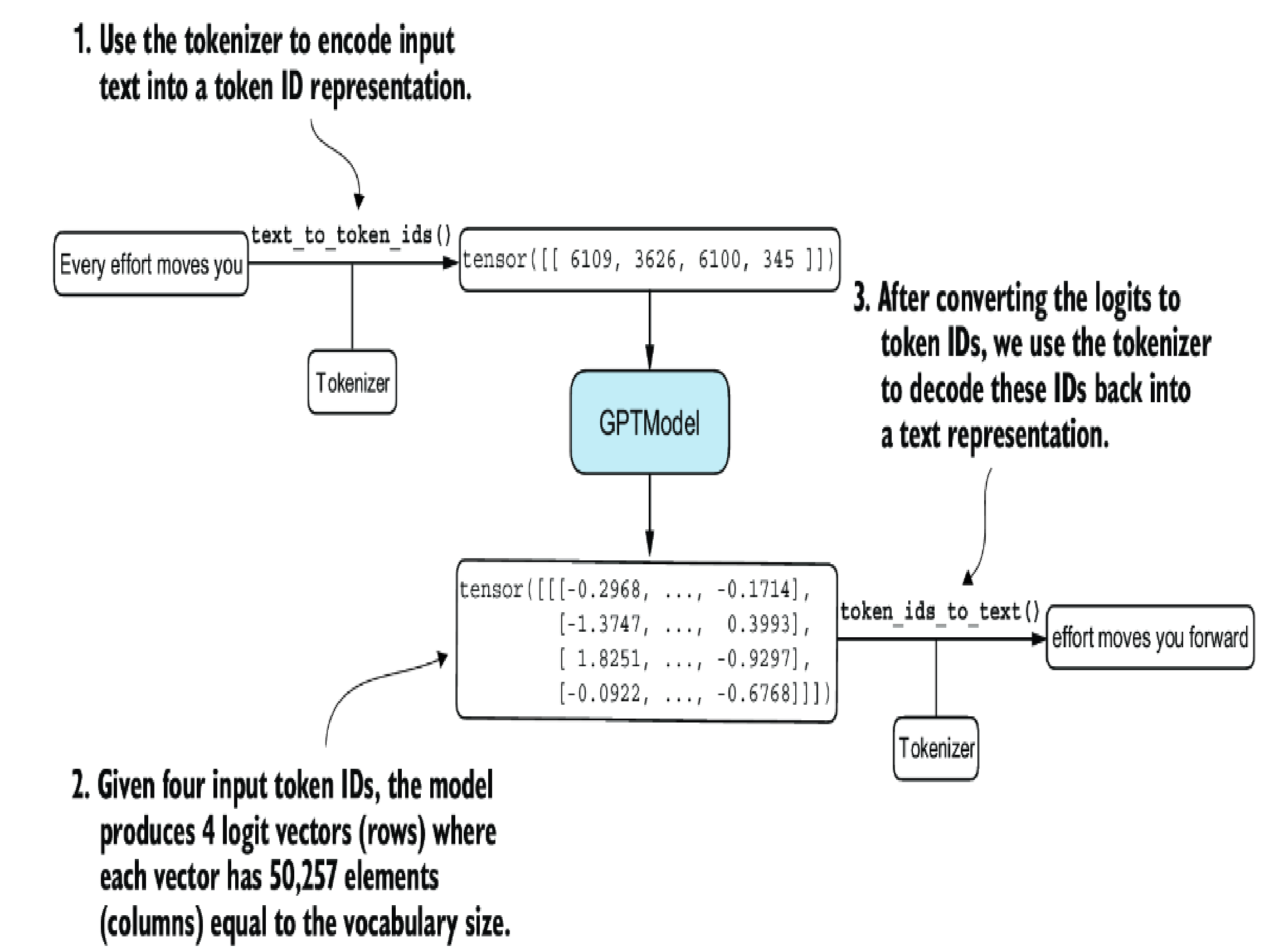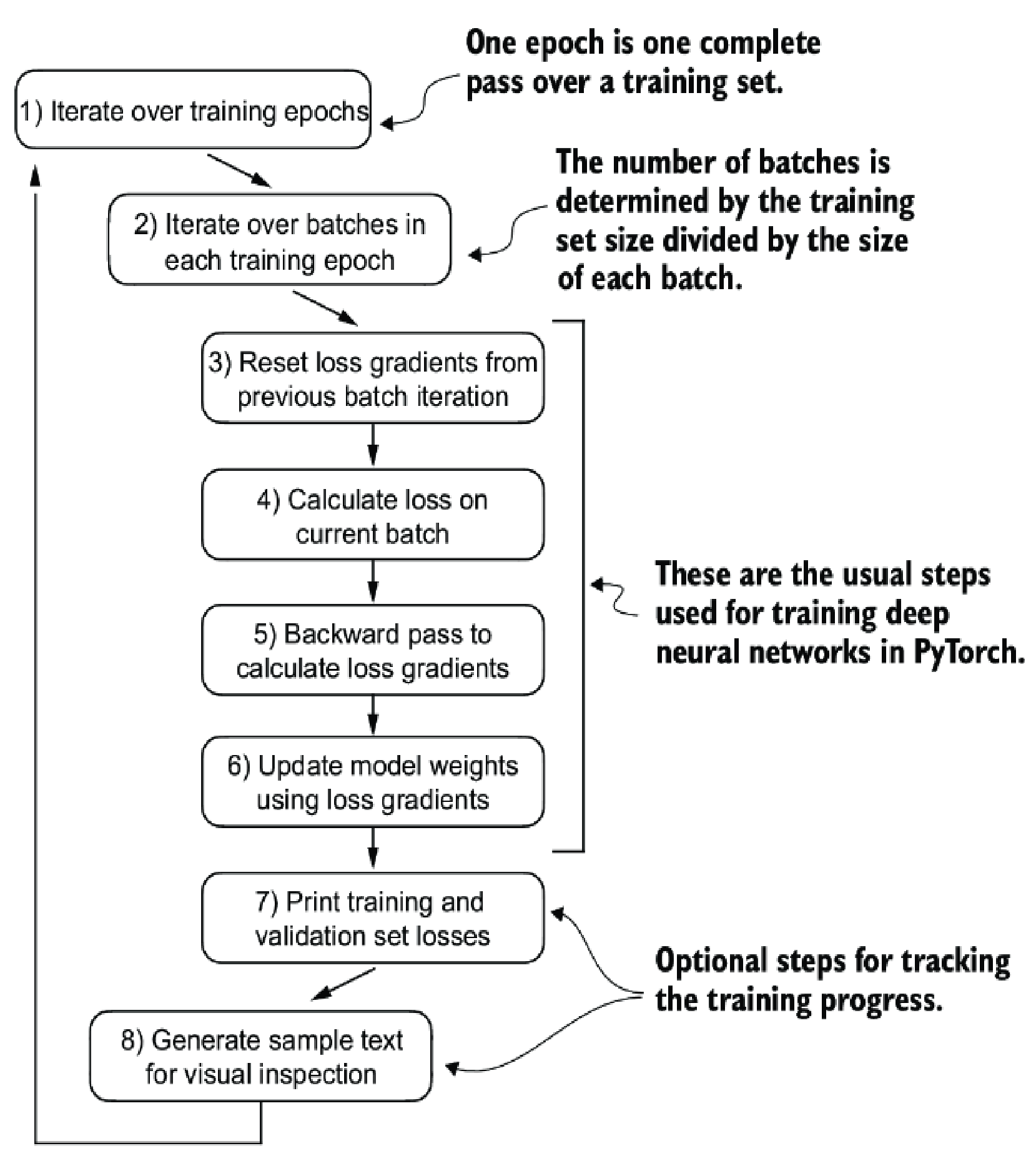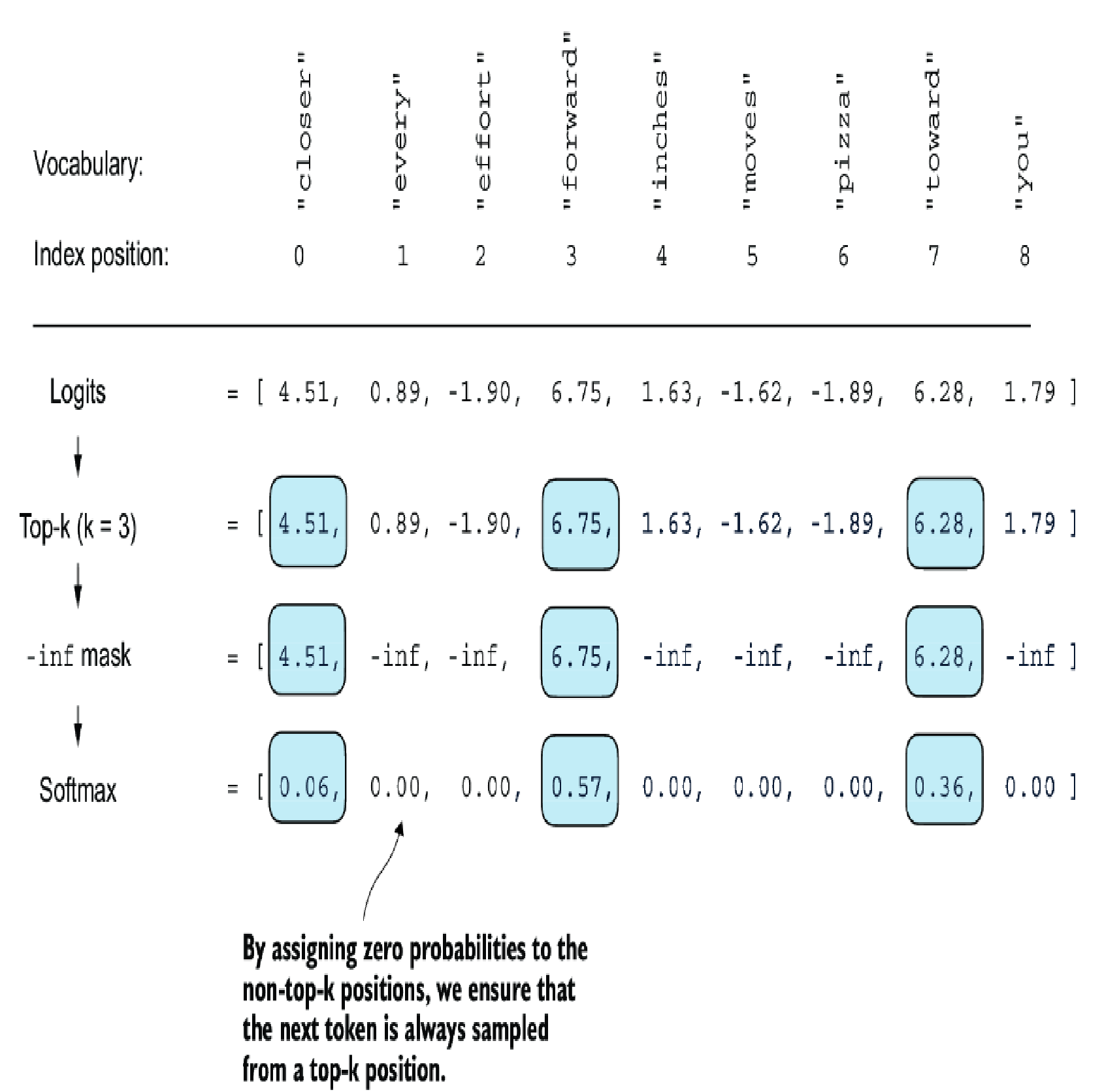Build a LLM (2/2)
Have you ever been curious about what makes large language models (LLMs) tick? Instead of just using them, why not try building one yourself?

This post is based mainly on my own experience while following the steps in the book, "Build a Large Language Model (from scratch)" by Sebastian Raschka.
Pretrain on unlabeled data
In short, we'll use all the steps we have done so far to make the GPT model to generate text based on the input, then calculate the training and loss by comparing the output with the training data. Then using backpropagation to adjust weight parameters to make the model be better on prediction human-like text.
Generate text

Runnable code
import tiktoken
import torch
from config import GPT_CONFIG_124M
from gpt import GPTModel, generate_text_simple
def text_to_token_ids(text, tokenizer):
encoded = tokenizer.encode(text, allowed_special={'<|endoftext|>'})
encoded_tensor = torch.tensor(encoded).unsqueeze(0) #1
return encoded_tensor
def token_ids_to_text(token_ids, tokenizer):
flat = token_ids.squeeze(0) #2
return tokenizer.decode(flat.tolist())
if __name__ == "__main__":
torch.manual_seed(123)
model = GPTModel(GPT_CONFIG_124M)
start_context = "Every effort moves you"
tokenizer = tiktoken.get_encoding("gpt2")
token_ids = generate_text_simple(
model=model,
idx=text_to_token_ids(start_context, tokenizer),
max_new_tokens=10,
context_size=GPT_CONFIG_124M["context_length"]
)
print("Output text:\n", token_ids_to_text(token_ids, tokenizer))generate.py
Evaluate the generated text
When model makes the prediction, it will returns its confidence for all tokens in the vocab library. In order words the command logits = model(inputs) will produce a tensor with shape of (batch_size, num_tokens, vocab_size) into logits. In which, batch_size is the number of sequence of inputs, num_tokens is the number of tokens in each input, and vocab_size is the vocabulary dictionary size.
Different from human behavior, when we tend compare the output with the expectation, in training LLM, the process just doesn't care its output (the final selected tokens), but tell the model which are our expected token probabilities from the digits it has just generated. Then the model will be able learn (or adjust) through the backpropagation process and this process requires a loss function.
Cross Entropy loss
At its core, the cross entropy loss is a popular measure in machine learning and deep learning that measures the difference between two probability distributions—typically, the true distribution of labels (here, tokens in a dataset) and the predicted distribution from a model (for instance, the token probabilities generated by an LLM).
# For the cross_entropy loss function in PyTorch, we want to
# flatten these tensors by combining them over the batch
# dimension
logits_flat = logits.flatten(0, 1)
targets_flat = targets.flatten()
loss = torch.nn.functional.cross_entropy(logits_flat, targets_flat)just a piece of code for understanding
tldr; there is a common misconception of cross entropy loss comparison. It does NOT compare the target token probabilities against the actual produced token probabilities. BUT it calculates the loss based on the target token probabilities with the FULL probability distribution over all tokens in vocab.
Perplexity
Perplexity measures how well the probability distribution predicted by the model matches the actual distribution of the words in the dataset. Similar to the loss, a lower perplexity indicates that the model predictions are closer to the actual distribution.
Backpropagation
This is indeed supported by the pytorch library, we just need 2 steps: loss.backward() to compute the gradient of loss backward through layers for each parameter, but it does not apply the changes. optimizer.step() is the actual application step from those gradient of loss computed just in previous command.
However, in order to apply the changes to the parameter, we also want to have way to optimize it so instead of just apply the gradient, we tend to have param = param - learning_rate * gradient
AdamW
Adam optimizers are a popular choice for training deep neural networks. AdamW is a variant of Adam that improves the weight decay approach, which aims to minimize model complexity and prevent overfitting by penalizing larger weights. This adjustment allows AdamW to achieve more effective regularization and better generalization; thus, AdamW is frequently used in the training of LLMs.
Training loop

import tiktoken
import torch
import os
import time
import urllib.request
import matplotlib.pyplot as plt
from matplotlib.ticker import MaxNLocator
from dataset import create_dataloader_v1
from generate import text_to_token_ids, token_ids_to_text
from gpt import GPTModel, generate_text_simple
def calc_loss_batch(input_batch, target_batch, model, device):
input_batch, target_batch = input_batch.to(device), target_batch.to(device)
logits = model(input_batch)
loss = torch.nn.functional.cross_entropy(logits.flatten(0, 1), target_batch.flatten())
return loss
def calc_loss_loader(data_loader, model, device, num_batches=None):
total_loss = 0.
if len(data_loader) == 0:
return float("nan")
elif num_batches is None:
num_batches = len(data_loader)
else:
# Reduce the number of batches to match the total number of batches in the data loader
# if num_batches exceeds the number of batches in the data loader
num_batches = min(num_batches, len(data_loader))
for i, (input_batch, target_batch) in enumerate(data_loader):
if i < num_batches:
loss = calc_loss_batch(input_batch, target_batch, model, device)
total_loss += loss.item()
else:
break
return total_loss / num_batches
def train_model_simple(model, train_loader, val_loader, optimizer, device, num_epochs,
eval_freq, eval_iter, start_context, tokenizer):
# Initialize lists to track losses and tokens seen
train_losses, val_losses, track_tokens_seen = [], [], []
tokens_seen, global_step = 0, -1
# Main training loop
for epoch in range(num_epochs):
model.train() # Set model to training mode
for input_batch, target_batch in train_loader:
optimizer.zero_grad() # Reset loss gradients from previous batch iteration
loss = calc_loss_batch(input_batch, target_batch, model, device)
loss.backward() # Calculate loss gradients
optimizer.step() # Update model weights using loss gradients
tokens_seen += input_batch.numel()
global_step += 1
# Optional evaluation step
if global_step % eval_freq == 0:
train_loss, val_loss = evaluate_model(
model, train_loader, val_loader, device, eval_iter)
train_losses.append(train_loss)
val_losses.append(val_loss)
track_tokens_seen.append(tokens_seen)
print(f"Ep {epoch+1} (Step {global_step:06d}): "
f"Train loss {train_loss:.3f}, Val loss {val_loss:.3f}")
# Print a sample text after each epoch
generate_and_print_sample(
model, tokenizer, device, start_context
)
return train_losses, val_losses, track_tokens_seen
def evaluate_model(model, train_loader, val_loader, device, eval_iter):
model.eval()
with torch.no_grad():
train_loss = calc_loss_loader(train_loader, model, device, num_batches=eval_iter)
val_loss = calc_loss_loader(val_loader, model, device, num_batches=eval_iter)
model.train()
return train_loss, val_loss
def generate_and_print_sample(model, tokenizer, device, start_context):
model.eval()
context_size = model.pos_emb.weight.shape[0]
encoded = text_to_token_ids(start_context, tokenizer).to(device)
with torch.no_grad():
token_ids = generate_text_simple(
model=model, idx=encoded,
max_new_tokens=50, context_size=context_size
)
decoded_text = token_ids_to_text(token_ids, tokenizer)
print(decoded_text.replace("\n", " ")) # Compact print format
model.train()
def plot_losses(epochs_seen, tokens_seen, train_losses, val_losses):
fig, ax1 = plt.subplots(figsize=(5, 3))
# Plot training and validation loss against epochs
ax1.plot(epochs_seen, train_losses, label="Training loss")
ax1.plot(epochs_seen, val_losses, linestyle="-.", label="Validation loss")
ax1.set_xlabel("Epochs")
ax1.set_ylabel("Loss")
ax1.legend(loc="upper right")
ax1.xaxis.set_major_locator(MaxNLocator(integer=True)) # only show integer labels on x-axis
# Create a second x-axis for tokens seen
ax2 = ax1.twiny() # Create a second x-axis that shares the same y-axis
ax2.plot(tokens_seen, train_losses, alpha=0) # Invisible plot for aligning ticks
ax2.set_xlabel("Tokens seen")
fig.tight_layout() # Adjust layout to make room
plt.savefig("loss-plot.png")
plt.show()
# Note:
# Uncomment the following code to calculate the execution time
start_time = time.time()
file_path = "the-verdict.txt"
url = "https://raw.githubusercontent.com/rasbt/LLMs-from-scratch/main/ch02/01_main-chapter-code/the-verdict.txt"
if not os.path.exists(file_path):
with urllib.request.urlopen(url) as response:
text_data = response.read().decode('utf-8')
with open(file_path, "w", encoding="utf-8") as file:
file.write(text_data)
else:
with open(file_path, "r", encoding="utf-8") as file:
text_data = file.read()
# Train/validation ratio
train_ratio = 0.90
split_idx = int(train_ratio * len(text_data))
train_data = text_data[:split_idx]
val_data = text_data[split_idx:]
GPT_CONFIG_124M = {
"vocab_size": 50257, # Vocabulary size
"context_length": 256, # Context length
"emb_dim": 768, # Embedding dimension
"n_heads": 12, # Number of attention heads
"n_layers": 12, # Number of layers
"drop_rate": 0.1, # Dropout rate
"qkv_bias": False # Query-Key-Value bias
}
torch.manual_seed(123)
model = GPTModel(GPT_CONFIG_124M)
device = torch.device("cuda" if torch.cuda.is_available() else "cpu")
model.to(device)
optimizer = torch.optim.AdamW(model.parameters(), lr=0.0004, weight_decay=0.1)
train_loader = create_dataloader_v1(
train_data,
batch_size=2,
max_length=GPT_CONFIG_124M["context_length"],
stride=GPT_CONFIG_124M["context_length"],
drop_last=True,
shuffle=True,
num_workers=0
)
val_loader = create_dataloader_v1(
val_data,
batch_size=2,
max_length=GPT_CONFIG_124M["context_length"],
stride=GPT_CONFIG_124M["context_length"],
drop_last=False,
shuffle=False,
num_workers=0
)
# Initialize the tokenizer
tokenizer = tiktoken.get_encoding("gpt2")
num_epochs = 10
train_losses, val_losses, tokens_seen = train_model_simple(
model, train_loader, val_loader, optimizer, device,
num_epochs=num_epochs, eval_freq=5, eval_iter=5,
start_context="Every effort moves you", tokenizer=tokenizer
)
epochs_tensor = torch.linspace(0, num_epochs, len(train_losses))
plot_losses(epochs_tensor, tokens_seen, train_losses, val_losses)
# Note:
# Uncomment the following code to show the execution time
end_time = time.time()
execution_time_minutes = (end_time - start_time) / 60
print(f"Training completed in {execution_time_minutes:.2f} minutes.")simple_training.py
Save trained weights
In the context of LLMs and other deep learning models, weights refer to the trainable parameters that the learning process adjusts. These weights are also known as weight parameters or simply parameters. And saving a model simply just saving it's parameters of all layers into a format. With PyTorch, it is relative straightforward:
torch.save(model.state_dict(), "model.pth")save model parameters
Load model checkpoint
model = GPTModel(GPT_CONFIG_124M)
model.load_state_dict(torch.load("model.pth", map_location=device))
model.eval()If we use AdamW for optimizing and want to continue the training process, then we must save the state of AdamW, because it use historical data to adjust learning rates for each model parameter dynamically.
torch.save({
"model_state_dict": model.state_dict(),
"optimizer_state_dict": optimizer.state_dict(),
},
"model_and_optimizer.pth"
)save checkpoint for further processing
checkpoint = torch.load("model_and_optimizer.pth", map_location=device)
model = GPTModel(GPT_CONFIG_124M)
model.load_state_dict(checkpoint["model_state_dict"])
optimizer = torch.optim.AdamW(model.parameters(), lr=5e-4, weight_decay=0.1)
optimizer.load_state_dict(checkpoint["optimizer_state_dict"])
model.train();load checkpoint with optimizer parameters
Decoding strategies to control
randomness
Temperature scaling
Temperature scaling is just a fancy description for dividing the logits by a number greater than 0. So before computing the token probabilities by softmax function after the model has done the prediction.
def softmax_with_temperature(logits, temperature):
scaled_logits = logits / temperature
return torch.softmax(scaled_logits, dim=0)temperature scaling before softmax
Top-k sampling
Top-k sampling, when combined with probabilistic sampling and temperature scaling, can improve the text generation results. In top-k sampling, we can restrict the sampled tokens to the top-k most likely tokens and exclude all other tokens from the selection process by masking their probability scores.

Runnable code
import tiktoken
import torch
from generate import text_to_token_ids, token_ids_to_text
from gpt import GPTModel
def generate(model, idx, max_new_tokens, context_size, temperature=0.0, top_k=None, eos_id=None):
# For-loop is the same as before: Get logits, and only focus on last time step
for _ in range(max_new_tokens):
idx_cond = idx[:, -context_size:]
with torch.no_grad():
logits = model(idx_cond)
logits = logits[:, -1, :]
# New: Filter logits with top_k sampling
if top_k is not None:
# Keep only top_k values
top_logits, _ = torch.topk(logits, top_k)
min_val = top_logits[:, -1]
logits = torch.where(logits < min_val, torch.tensor(float("-inf")).to(logits.device), logits)
# New: Apply temperature scaling
if temperature > 0.0:
logits = logits / temperature
# Apply softmax to get probabilities
probs = torch.softmax(logits, dim=-1) # (batch_size, context_len)
# Sample from the distribution
idx_next = torch.multinomial(probs, num_samples=1) # (batch_size, 1)
# Otherwise same as before: get idx of the vocab entry with the highest logits value
else:
idx_next = torch.argmax(logits, dim=-1, keepdim=True) # (batch_size, 1)
if idx_next == eos_id: # Stop generating early if end-of-sequence token is encountered and eos_id is specified
break
# Same as before: append sampled index to the running sequence
idx = torch.cat((idx, idx_next), dim=1) # (batch_size, num_tokens+1)
return idx
if __name__ == "__main__":
torch.manual_seed(123)
device = torch.device("cuda" if torch.cuda.is_available() else "cpu")
checkpoint = torch.load("model_and_optimizer.pth", map_location=device)
# This config must be exactly same as the trained one.
GPT_CONFIG_124M = {
"vocab_size": 50257, # Vocabulary size
"context_length": 256, # Context length
"emb_dim": 768, # Embedding dimension
"n_heads": 12, # Number of attention heads
"n_layers": 12, # Number of layers
"drop_rate": 0.1, # Dropout rate
"qkv_bias": False # Query-Key-Value bias
}
model = GPTModel(GPT_CONFIG_124M)
model.load_state_dict(checkpoint["model_state_dict"])
# Using model.eval()
# switches the model to evaluation mode for inference,
# disabling the dropout layers of the model
model.eval()
tokenizer = tiktoken.get_encoding("gpt2")
token_ids = generate(
model=model,
idx=text_to_token_ids("Every effort moves you", tokenizer),
max_new_tokens=15,
context_size=GPT_CONFIG_124M["context_length"],
top_k=25,
temperature=1.4
)
print("Output text:\n", token_ids_to_text(token_ids, tokenizer))generate text with temperature and top-k sampling


Comments ()